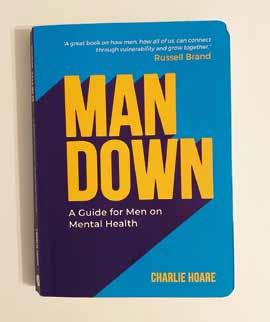
7 minute read
Looking at Loneliness
LOOKING AT LONELINESS
HOW CAN WE TACKLE ITS EFFECTS ON MENTAL HEALTH?
Advertisement
The field of loneliness research has really exploded in recent years. The last 12 months, in particular, has put loneliness in the media spotlight, as the pandemic has proved mentally challenging for many of us.
Prof. Roz Shafran, Charlie Waller Trustee and Professor of Translational Psychology at the UCL Institute of Child Heath, takes a closer look at loneliness, ways in which we can support young people and some of the psychological interventions that may help.
Loneliness – a national concern
The coronavirus pandemic temporarily severed many of our most trusted and valued social connections. It caused our whole nation to withdraw into their homes, to become largely reliant on technology for daily life and to limit direct contact with others. Feelings of loneliness have also been compounded for many by health and money worries.
Yet loneliness was a big societal concern before Covid came along. This is likely still to be the case long after a sense of 'normality' has returned to our lives. It’s also a much bigger issue than you might expect, in a world that has, in some ways, never been more connected.
While loneliness is difficult to measure, the Campaign to End Loneliness reports that almost half of UK adults feel occasionally, sometimes or often lonely in England; this equates to over 25 million people. The associated health risks are considerable: loneliness, living alone and poor social connections are as bad for your health as smoking 15 cigarettes a day, and research has found that loneliness is likely to increase your risk of death by as much as 26%. Loneliness also seems to affect younger and older people disproportionately: those aged under 25 years and over 65 are most at risk.
Two sides of loneliness
A vast umbrella review with over 745,000 participants and 795 studies has emphasised the strong relationship between loneliness and mental health problems: it found that loneliness is significantly associated with suicide attempts and depressive symptoms - and revealed that age, gender, socioeconomic status and the quality of social contacts all play a role in loneliness.
Loneliness is, essentially, a two-sided issue. On the one hand, there are the internal psychological factors to consider. These include, but are not limited to, attitudes to participating in social interactions, beliefs about other people and our own beliefs about ourselves. All these feelings and beliefs, mostly played out in our own heads, can contribute towards a perception that we are not fully connected with the people and communities that surround us, or that we are not valued.
A host of external factors can be found on the other side of the coin, varying from person to person. For some, loneliness could be caused by living far away from family and friends, having few people locally with whom to spend time in person, in deep, long-term relationships. For others, loneliness may arise following a bereavement or another significant life event, leading to a withdrawal or disconnectedness from the wider world.
It’s difficult to separate these two aspects of loneliness; they interact and, in many instances, overlap. Research into loneliness, to date, has largely been siloed, tending to concentrate on one side of the issue at a time. Yet it’s vital to bring together the interweaving relationship between individual psychological factors and external environmental factors - as it is the combination of these that gives us the whole picture.
Loneliness could also be understood as falling into two different categories: emotional and social. Emotional loneliness occurs when an individual has an absence of a confidant or trusted persons to turn to during a crisis. Social loneliness looks at the broader circumstances a person may find themselves in, specifically a lack of social integration and embeddedness in the world around them. The key to growing and maintaining positive mental health and preventing psychological distress is to ensure that feelings of both emotional and social loneliness are successfully overcome.

Positive interventions can make a difference
There are proven ways in which feelings of loneliness can be positively challenged –interventions that can help someone who is struggling to feel more connected with others.
One of the most widely cited studies into loneliness found that enhancing social support, improving social skills, increasing opportunities for social contact and addressing negative thought patterns (maladaptive social cognition) all helped to reduce loneliness. The study broadly revealed that the most successful interventions are psychological.
The six key categories of intervention
Facilitating social interactions
Befriending
Psychological therapies
Health and social care provision
Animals
Leisure/skill development
Loneliness in young people
75% of all mental health problems begin before the age of 18, so trying to look at loneliness amongst young people is clearly critical to preventing the development of mental health problems in later life.
Reviews into how to alleviate loneliness in young people are beginning to gather momentum, and as we emerge from the grip of the pandemic, there will be a lot of work needed to explore and understand the role that loneliness has had on our young people – and how best to overcome this.
A 2016 Health & Social Care in the Community study identified six key categories of intervention that could have a positive impact on feelings of loneliness and social isolation:
A psychological intervention to combat loneliness that has grown in popularity in recent years has been mindfulness training. Based on social psychology rather than clinical psychology, studies have shown that mindfulness can not only increase mental stability but also improve overall wellbeing.
Meta-analyses also support the use of cognitive behavioural therapy (CBT). Delivered either face-to-face or digitally, CBT techniques can help to effectively address a range of mental health difficulties that are linked to loneliness, including social anxiety, depression, panic disorder and insomnia.
A two-year study has explored internet-administered CBT for loneliness, with reductions in loneliness reported posttreatment, although studies have not, to date, focused specifically on reducing loneliness in young people more generally. We need to think about how to engage with and support the hard-to-reach when it comes to our young people, especially as we move forward into the ‘new normal’, and consider the use of digital interventions when face-to-face support is not feasible or desirable.
So, as we emerge from the pandemic, will we begin to see greater strides made in tackling the issue of loneliness, especially amongst our young people? The challenge now is to ensure that someone who is socially anxious or depressed can have the opportunity to work with psychologists, counsellors and clinicians in a manner and environment that is comfortable to them. We need to create more safe spaces and opportunities to talk about and tackle loneliness together.
Loneliness can be addressed, but it’s the sum of the parts that makes a difference: theorybased psychological techniques need to be combined with research evidence, clinical expertise and people’s real lived experiences. While it is encouraging to see great enthusiasm for, and research undertaken into the effectiveness of, a range of psychological interventions, it’s apparent that when it comes to loneliness, there isn’t a one-size-fitsall approach and that interventions need to be tailored to the individual.
Loneliness toolkit
Information for adults who support young people
The University of Bath, University of Manchester, and University College London have worked together to produce a toolkit on loneliness and reconnection, for adults who support young people.
It includes useful pointers about loneliness…
• Loneliness is normal – almost everyone will be affected by it at some point in their life
• It is not just sadness – it can include anger, pain and frustration
• Loneliness can be a response to wanting more friends or closer relationships
• It’s not always about being on our own – we can sometimes feel lonely in the company of others.
…and things that might help:
Talk about loneliness – open up the space so it’s okay for young people to say they’re lonely
Don’t dismiss or minimise loneliness
Explore what loneliness means and the forms it can take
Understand that young people may need space and time to (re)learn to be with each other
You can download the full toolkit here: bath.ac.uk/publications/lonelinessand-reconnection-guide/attachments/ loneliness-reconnection-guide.pdf
References
Gardiner C, Geldenhuys G, Gott M. Interventions to reduce social isolation and loneliness amongst older people: an integrative review. Health & Social Care in the Community 2016 doi: 10.1111/hsc.12367
J Holt-Lunstad, TB Smith, M Baker, T Harris, D Stephenson. Perspectives on psychological science 10 (2), 227-237










